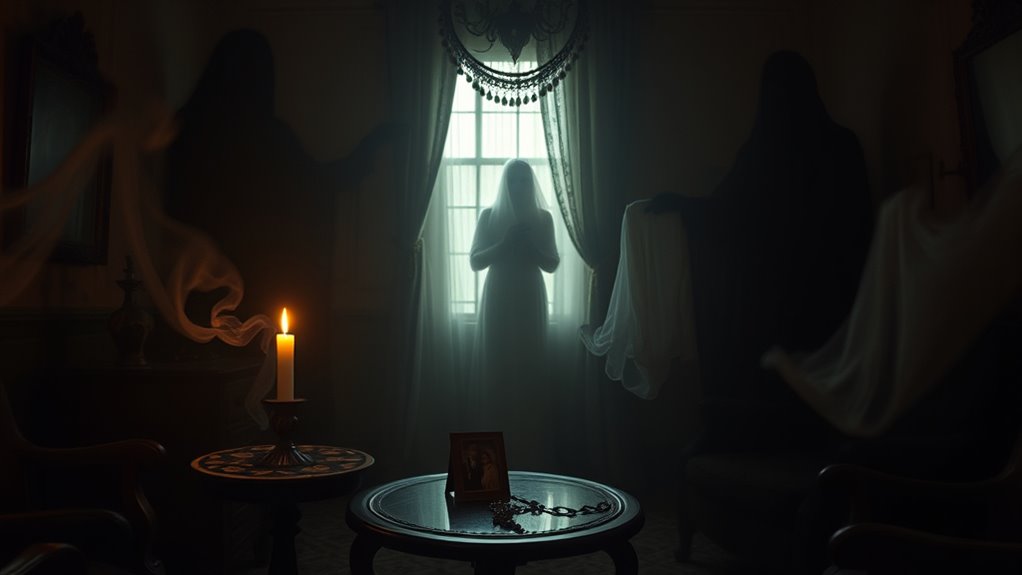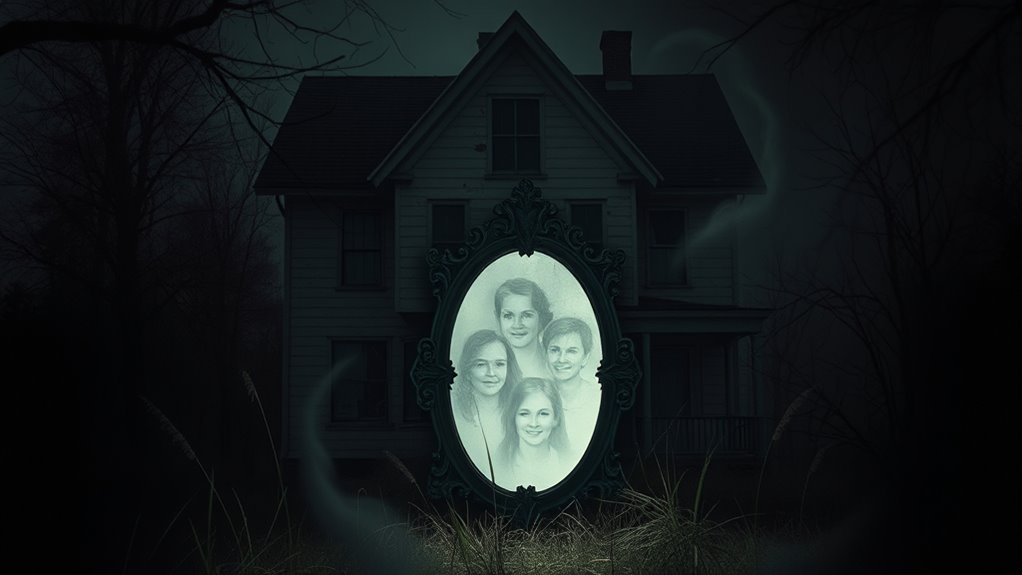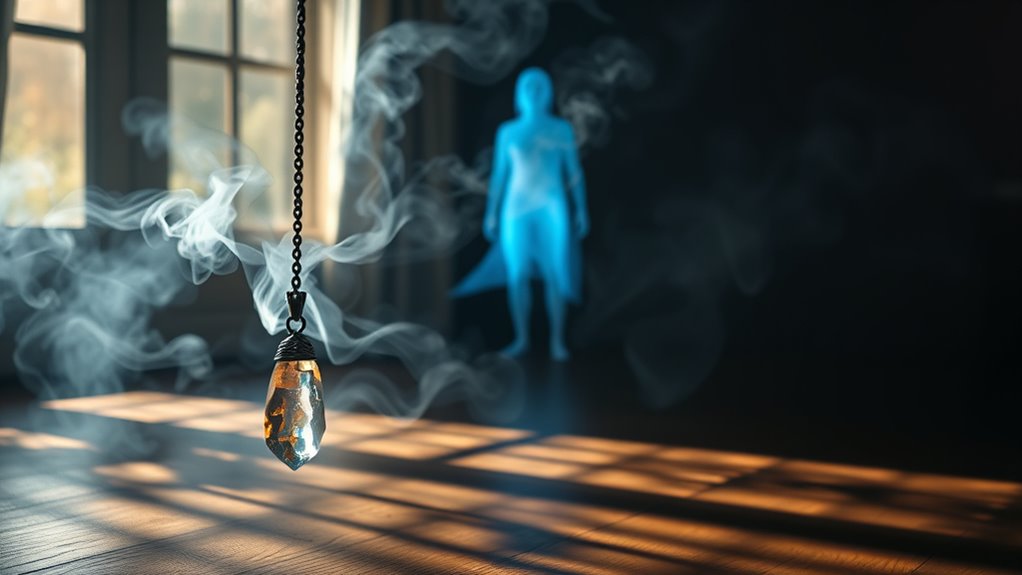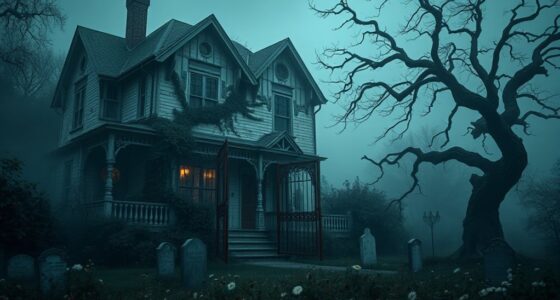Not all ghosts are evil! In fact, many ghosts represent unresolved emotions or past experiences rather than malevolent intentions. Instead of fear, try to approach these encounters with empathy. Positive spirits can bring warmth and comfort, while negative ones might evoke unease. Understanding the nature of these entities allows for better interactions. If you want to discover distinctions between ghosts and spirits, as well as how to communicate with them, there’s more to explore!
Key Takeaways
- Not all ghosts are malevolent; many represent unresolved human emotions and past events rather than evil intentions.
- Positive spirits can bring warmth, comfort, and laughter, while negative spirits may induce unease or dread.
- Ghosts often replay emotions or events without awareness, lacking consciousness and intent.
- Empathy can replace fear in ghostly encounters, leading to better understanding and connection.
- Spirits can reflect human problems, and many seek connection rather than confrontation, promoting healing experiences.
Understanding the Nature of Ghosts

When you think about ghosts, it’s easy to assume they’re all out to scare you, but understanding their true nature reveals a different story.
Ghosts are often neutral manifestations of human spirits, replaying emotions or events without any awareness of their surroundings. They lack consciousness and can seem stuck in time, which distinguishes them from more aware spirits.
Ghosts often replay emotions or events, lacking awareness and consciousness, which separates them from more aware spirits.
Many ghostly experiences aren’t inherently dangerous; instead, they reflect unresolved human emotions or problems. The negative energy you might feel during an encounter doesn’t necessarily indicate malevolence.
Often, it stems from benign interactions or a simple desire for attention. By recognizing ghosts as manifestations of human energy, you can approach these encounters with empathy rather than fear.
The Difference Between Spirits and Ghosts

When you think about spirits and ghosts, it’s essential to recognize their differences in consciousness and energy.
Spirits are aware and can interact with you, while ghosts often replay past events without any awareness.
Understanding these distinctions can help you interpret your encounters more accurately.
Consciousness and Awareness
The distinction between ghosts and spirits hinges on their levels of consciousness and awareness.
Ghosts are often just echoes of human energy, replaying past events without any awareness of their surroundings. They can evoke fear or confusion, as they seem stuck in their own loops.
In contrast, spirits possess consciousness and can interact with the physical world, offering guidance and support. They embody a wider range of emotions, both positive and negative.
Understanding this difference reveals that not all spiritual encounters are malevolent; many spirits reflect warmth and intuitive knowledge.
Manifestations and Energy Types
Understanding the different manifestations of energy is essential for grasping the distinction between spirits and ghosts.
Ghosts are often seen as neutral, replaying past experiences without any awareness or emotional intent. You might encounter them in familiar places, but they can leave you feeling confused or fearful due to their repetitive nature.
On the other hand, spirits are conscious entities, aware of their surroundings and capable of interacting with you in meaningful ways. They can embody both positive and negative traits, offering comfort or, at times, presenting challenges.
Engaging with spirits can lead to insights and emotional healing, while ghosts may reflect unresolved issues from your past. Recognizing these differences helps you navigate your experiences more effectively.
Common Misconceptions About Ghosts

You might think all ghosts are out to scare you, but that’s a common misconception.
Many ghosts simply represent unresolved emotions or past events without any malicious intent.
Spirits vs. Ghosts Explained
While many people often conflate ghosts and spirits, these two entities exist on different planes of consciousness and interaction.
Ghosts are manifestations of human energy, often lacking awareness of their existence. They typically replay past emotions and experiences, making them seem neutral rather than malicious.
On the other hand, spirits are conscious entities that can influence the physical environment, embodying both positive and negative traits.
This distinction is significant; many ghostly encounters aren’t inherently evil but reflect unresolved human emotions. You might misinterpret dark feelings or shadowy figures as malevolent, but these could simply be benign spirits or emotional residues.
Understanding these differences can turn fear into empathy, allowing you to see their often human-like qualities.
Misunderstood Spirit Intentions
Many people misinterpret ghostly encounters as signs of evil intentions, but this misconception stems from a lack of awareness about the nature of these entities.
Many ghosts are simply residual energies replaying past events, often unaware of their surroundings. Dark feelings or shadowy figures don’t always indicate malevolence; they might reflect human emotions or unresolved issues instead.
Just like human beings, spirits can possess both positive and negative traits. Many encounters involve spirits with human-like desires or emotional needs, offering comfort rather than fear.
Energy Imprints and Experiences
Understanding energy imprints in ghostly encounters can greatly alter your perception of these experiences.
Many ghosts aren’t evil; they’re simply residual energy imprints of significant past events, replaying emotions tied to those moments. These imprints often manifest as human forms, embodying the feelings of unresolved issues rather than malevolent intentions.
When you encounter unsettling figures or sensations, remember that benign spirits might be seeking your attention, not threatening you. This misinterpretation can lead to fear, but recognizing that many ghostly experiences stem from human emotions can change how you view them. Furthermore, exploring unexplained phenomena can provide deeper insights into the nature of these encounters.
The Spectrum of Spirit Intentions

Ghosts can often be misunderstood, as their intentions vary widely along a spectrum. Many spirits reflect human emotions and unresolved issues rather than embodying pure malevolence.
You might encounter a shadow person, which often evokes fear, but these figures can signify a spirit grappling with deep-seated feelings. Not all ghostly encounters are negative; some spirits radiate warmth and comfort, reminding us of the love they once knew.
Signs of Positive and Negative Spirits

Positive spirits often bring feelings of warmth, comfort, and even laughter. You might feel a gentle embrace of peace when they’re around, guiding you through tough times.
In contrast, negative spirits can induce unease, manifesting as cold drafts or a sense of dread. You may notice physical disturbances that create discomfort in your space.
While dark feelings or shadowy figures might seem threatening, they often reflect human emotions or unresolved issues rather than pure malevolence. Understanding the nature of haunted places can help you differentiate between these types of spirits and their intentions.
How to Communicate With Spirits

When you’re ready to communicate with spirits, it’s essential to approach the experience with an open mind and a sense of purpose.
Start by creating a positive energy around you, as this fosters a welcoming environment. Confidence and assertiveness can greatly enhance your ability to connect.
You might notice sounds like knocks or whispers, or even receive intuitive knowledge during your session. Understanding the spirit’s background and motivations can also deepen your connection, making your interactions more meaningful.
Remember to treat spirits with respect, acknowledging their presence and emotions. This respectful approach can lead to better communication and a greater understanding of their experiences.
Trust your instincts, and enjoy the journey of connecting with the unseen.
Creating Boundaries With Energetic Entities

While engaging with energetic entities can be intriguing, it’s essential to establish clear boundaries to protect your personal space.
Start by asserting your needs; if a spirit feels intrusive or uncomfortable, politely ask it to leave. Your positive energy and confidence are key; they can help deter negative influences and foster better communication.
Understanding a spirit’s background and motivations provides context, making boundary-setting more effective.
Utilize emotional protection techniques like visualization or grounding exercises to maintain your energy and create a safe environment.
Keeping a calm demeanor and using respectful language encourages positive interactions, as spirits often respond to the emotional state of people in the physical world.
Personal Experiences With Ghosts and Spirits

Personal encounters with ghosts and spirits often reveal a surprising depth of emotion and connection. Your personal experiences might evoke feelings of warmth and comfort, contrasting sharply with common fears.
Many report that spirits, sometimes even loved ones, may follow them home, showing human emotions rather than malicious intent. Understanding a spirit’s background can turn your fear into empathy, as many act out of a desire to protect rather than harm.
Spirits often reveal human emotions, turning fear into empathy as they seek to protect rather than harm.
Often, these spirits reflect human problems, revealing misunderstandings rather than pure malevolence. By maintaining emotional protection and positive energy, you can navigate these encounters, as spirits frequently mirror your emotional state.
Embracing this perspective can lead to healing connections with those who’ve passed.
Frequently Asked Questions
Are All Ghosts Evil?
No, not all ghosts are evil. You might find that many are simply manifestations of unresolved emotions or past experiences.
They often replay moments from their lives without any intention to harm. While some can evoke fear, it’s usually due to misunderstanding their nature.
Is There Any Proof of a Ghost?
Imagine walking through a dense forest, where whispers of past travelers echo around you.
When you ask if there’s proof of a ghost, you’re stepping into an area of experiences. Many claim to have felt a presence or seen shadows, but these moments can be subjective.
While science hasn’t definitively proven ghosts exist, personal stories and unexplained phenomena keep the debate alive, inviting you to explore the mysteries that linger just beyond perception.
How Do You Know if a Ghost Is Watching You?
If you think a ghost is watching you, pay attention to your surroundings.
You might feel a sudden chill or notice unexplained drops in temperature.
Listen for whispers or knocks; these sounds could signal the spirit’s presence.
You may also catch glimpses of shadows or fleeting figures.
If you feel anxious or uneasy, it’s another sign that something is observing you.
Trust your instincts and consider the atmosphere to gauge the situation.
What Does It Mean When a Spirit Visits You?
When a spirit visits you, it often means they’re seeking connection or have a message to share. You might feel warmth or peace, but sometimes, there’s an unsettling chill.
These spirits are aware and can interact with your environment, influencing your emotions. Understanding their motivations can help you transform fear into empathy, allowing you to recognize their need for acknowledgment or resolution.
Approach these encounters with respect, and you might gain valuable insights.
Conclusion
In the end, not all ghosts are evil; they’re like shadows in a dimly lit room, some bringing comfort while others might spook you. Understanding their intentions can illuminate your path, helping you distinguish between the friendly and the fearsome. By setting boundaries and communicating with respect, you can create a safe space for both you and the spirits. Embrace the mystery and remember, every encounter can teach you something new about the unseen world around us.









